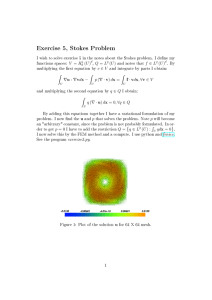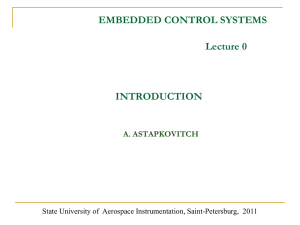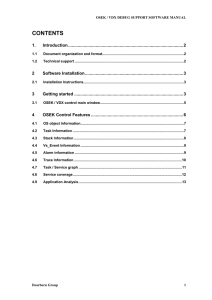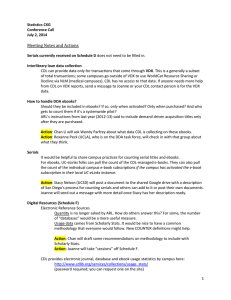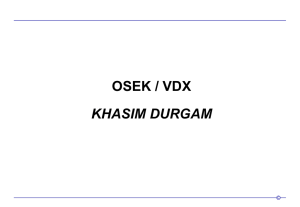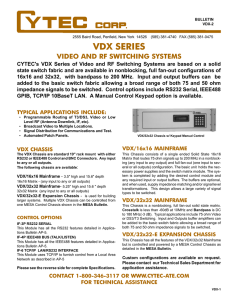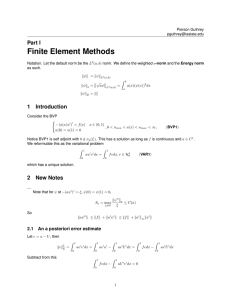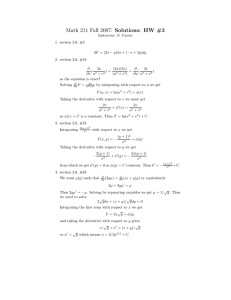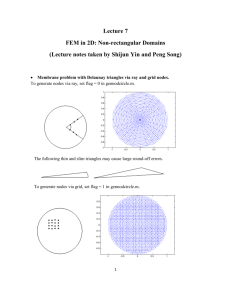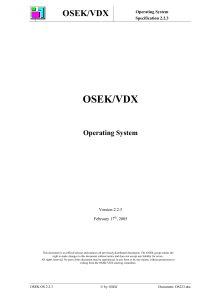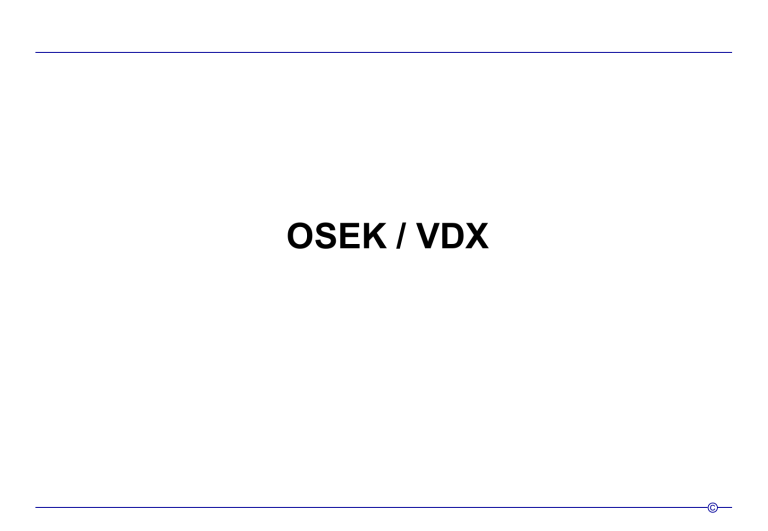
OSEK / VDX © OSEK / VDX > Agenda OSEK/VDX Standard - Overview OSEK/VDX Operating System – Overview (Task Concept, Scheduler, Events) © OSEK/VDX > What is OSEK/VDX? • Joint project of the European automotive industry Target: Define an industry standard for an open-ended architecture for distributed control units in vehicles. • Founded 1993 OSEK: Offene Systeme und deren Schnittstellen für die Elektronik im Kraftfahrzeug (“Open Systems and the Corresponding Interfaces for Automotive Electronics”) VDX: Vehicle Distributed eXecutive Joined OSEK in 1994 OSEK/VDX © OSEK/VDX > OSEK Specifications OSEK OS – serves as a basis for the controlled real-time execution of concurrent applications OSEK OIL – OIL provides a possibility to configure an OSEK/VDX application inside a particular CPU OSEK COM / NM – provides interfaces and protocols for the transfer of data within vehicle networks © OSEK/VDX > Goals & Motivations • Definition of standardized interfaces & protocols (HW & Network independent) Portability, Reusability & Extendibility of SW (through different HW platforms & different applications) Possible "co-habitation" of software from different suppliers Independence regarding a particular implementation • Definition of configurable & scalable functionalities Optimal adjustment of the architecture to a particular context (i.e. same OSEK/VDX interfaces, but different implementations, depending on the hardware architecture and the performance required) Quality improvement Savings in costs and development time © OSEK/VDX > Automotive Embedded Control Software > OSEK/VDX Architecture Electronic Control Unit Embedded Control Software OSEK/VDX OS OSEK/VD X NM Function D Function C Function B Actuators IO SW Function A Sensors OSEK/VDX COM System Bus (e.g. CAN) © OSEK/VDX > OSEK COM Architecture © OSEK/VDX > Goals & Motivations > Reusability HW Platform A HW Platform B OSEK/VDX OS OSEK/VDX OS Application OSEK/VDX NM Application OSEK/VDX NM OSEK/VDX COM OIL OSEK/VDX COM OIL Bus protocol x Bus protocol y © OSEK/VDX > Goals & Motivations > Distributed functions HW Platform HW Platform OSEK/VDX OS OSEK / VDX OSEK / VDX HW Platform OSEK/VDX OS OSEK / VDX A NM OSEK/VDX COM A OSEK/VDX OS B NM OSEK/VDX COM B C NM OSEK/VDX COM HW Platform OSEKOSEK/VDX COM / VDX C NM OSEK/VDX OS © OSEK/VDX Operating System > Overview COUNTER ALARM EVENT - Single processor operating system Implementations available for ISR RESOURCE 8/16/32 bit µC - Minimum ROM, RAM and CPU time consumption Statically defined resources (tasks, events, alarms, ...) TASK HOOK Different levels of functionality (conformance classes) - Standardized operating system behavior and interfaces for the application Services defined according to the ISO/ANSI-C syntax Independent from a specific µC MESSAGE © OSEK/VDX Operating System > Conformance Classes Four conformance classes in the one standard – provides convenient groups of features to ease understanding – enables partial implementations – scalability BCC: Basic tasks ECC: Extended tasks Level 1: One task per priority, one activation per task Level 2: More than one task per priority and more than one activation per task Overheads ECC2 ECC1 BCC2 BCC1 Features © OSEK/VDX Operating System > Task management Basic tasks only release the processor if – they terminate, the OSEK OS switches to a higher priority task (preemption) or an interrupt occurs Extended tasks – can also wait on events (WaitEvent API call) Wait Waiting Running Preempt Release Start Ready Terminate Suspended Activate © OSEK/VDX Operating System > Scheduler Scheduler •The scheduler decides on the basis of the task priority which is the next of the ready tasks to be transferred into the running state. • A preempted task is considered to be the first (oldest) task in the ready list of its current priority. • A task being released from the waiting state is treated like the last (newest) task in the ready queue of its priority. © OSEK/VDX Operating System > Scheduler The fundamental steps to determine the next task to be processed are: • The scheduler searches for all tasks in the ready/running state. • From the set of tasks in the ready/running state, the scheduler determines the set of tasks with the highest priority. • Within the set of tasks in the ready/running state and of highest priority, the scheduler finds the oldest task. © OSEK/VDX Operating System > Preemptive & NonPreemptive Scheduling Non- Preemptive Scheduling Preemptive Scheduling © OSEK/VDX Operating System > Interrupt Processing Two interrupt service routine categories – Category 1: • ISR does not use OS services • ISR executes above the priority level of the scheduler • No additional interrupt latency due to the OS – Category 2: • ISR can use OS services, e.g. activate tasks, etc. • ISR executes under the control of the scheduler • OS imposes some additional latency to set up the ISR environment © OSEK/VDX Operating System > Resource management OSEK requires the use of the priority ceiling protocol for resource management: – – – – Priority inversion minimised Deadlock cannot occur Access to resource never results in a waiting state Can be analysed to enable real-time performance to be guaranteed S1 ceiling = high © OSEK/VDX Operating System > Priority Inversion © OSEK/VDX Operating System > Deadlock © OSEK/VDX Operating System > Solution for Priority Inversion & Deadlock 1. 2. 3. 4. 5. 6. Task T0 has the highest, and task T4 the lowest priority. Task T1 and task T4 access the same standard resource. Task T4 get the resource and raise its priority to the ceiling priority. Task T0 preempts task T4 because its has a higher priority. When task T0 finishes, task T4 continues to run and release the standard resource. Task T1 which is ready to run get the resource and preempts task T4. Task T4 is put into ready state. Task T1 finishes and release resource. Since task T2 and T3 are ready, task T4 must wait for task T2 and T3 to complete before it can continues its tasks. © OSEK/VDX Operating System > Alarms Provides support for processing recurring events – The recurring events (sources) are registered by implementation specific counters – Based on the counters the OSEK OS provides alarm mechanisms to the application developer Counters provide a counter value measured in ‘ticks’ Alarms expire when a predefined counter value is reached, it can then: – Activate a task – Set an event © OSEK/VDX Operating System > Hook Routines StartupHook • Called at OS startup, interrupt disabled • Can be used for initialization purpose ShutdownHook • Called at OS shutdown, interrupt disabled • Can be used for epilogue purpose PreTaskHook • Called when a task enters the running state of a task • Not to be used due to CPU time consumption PostTaskHook • Called when a task exits the running state of a task • Not to be used due to CPU time consumption ©
